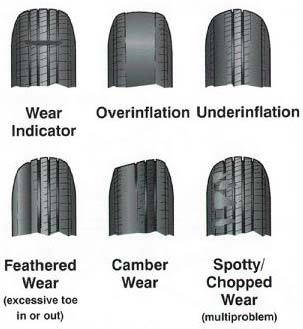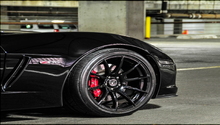Corvette: Why are My Tires Wearing Unevenly?
Are your tires wearing unevenly? Whether the excessive wear is in the front or the back, and the inside or the outside of the tires, there are a number of reasons why this could be happening. Check out our guide to help you diagnose and correct your uneven tire wear.
This article applies to the Corvette C5 (1997-2004), C6 (2005-2013), and C7 (2014-2015).
Tires that wear unevenly can cause a number of problems, including reduced tread life, a decrease in performance, annoying noises, or even the car pulling to one side. There are also a number of causes that lead to uneven wear, including some that are easy fixes and some that are not so easy. The good news is, just about anyone can complete the diagnostic in their own driveway with little skills or specialized tools.

Materials Needed
- Tire pressure gauge
- Air compressor
Step 1 - Check Your Air Pressure
Improper air pressure will cause uneven wear.
Check your air pressure in all four tires. If the tires are under inflated or over inflated, this can cause tires to wear in specific patterns. If you find that your tires are under or over inflated per the specs on the tire, inflate them to proper spec. If the wear is on both shoulders of the tire, they are likely under inflated. If the wear is in the center, they are likely over inflated. If the wear is mild, rotating the tires may help. However, it is still a good idea to get the tires checked out by a reputable shop to ensure they are safe to continue using.

Pro Tip
The recommended tire pressure can be found on the inside of the door jamb and on the tires themselves.
If tire pressure isn't the issue, continue on to Step 2.
Step 2 - Check For Bent Wheels
A bent wheel can affect tire wear.
Bent wheels can affect tire wear not only on the tire mounted on the wheels that is bent, but the others as well. Typically a bent wheel will cause the car to vibrate while moving. Follow along the bead of the tire where it follows the contour of the wheel. A bend in the wheel will be mirrored by a bend in the tire's shoulder tread as the sidewall will dip to meet the wheel bend. If you have a bent wheel, take it to a reputable shop. They can determine if it can be fixed or if it will have to be replaced completely.

If you don't have any wheel damage, move on to Step 3.
Step 3 - Check Your Alignment
An incorrect alignment is the most common cause of uneven tire wear.
A car that is out of balance or has an incorrect alignment is the most common cause of uneven tire wear. A 4 point alignment ensures that the tires are parallel to each other and flat on the pavement, which leads to optimal and even tire wear. As we drive over bumps and holes in the road, the alignment can get thrown off, leading to a number of different wear patterns on the tires. If you see wear on only one shoulder of a tire or find one block edge that is higher than another, or if you hear a humming or noise or feel a wobbling sensation while driving, you most likely have an alignment issue. While you can certainly do a 4 wheel alignment at home with the right tools and a little online research, most tend to leave this kind of delicate work to the professionals.

Related Discussions
- Uneven tire wear on C6 Z51 - CorvetteForum.com
- Uneven front tire wear - CorvetteForum.com
- Uneven rear tire wear - CorvetteForum.com






